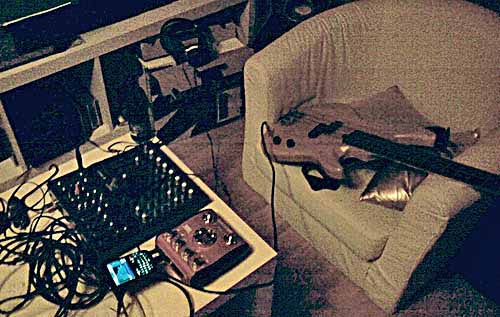A studio musician may be more concerned with the pedal’s editing and looping capabilities, while a student might be looking at the unit’s practice room features and the cost. Just as there’s no one best bass guitar, there is no single effects pedal that works perfectly for everybody, but the 4 pedals below all offer professional quality and excellent value—and could be each be christened the best bass multi effects pedal:
Zoom B3n Multi-Effects Processor
The Zoom B3n is one of the most advanced effect petals on the market. It features 67 onboard DSP effects and 10 amp/cabinet models, including emulations of classic tube amps like the Marshall Super Bass and Fender Bassman. The unique design features 3 stompbox-style displays, each with its own controls and foot switch that can be chained together or used independently. The interface is intuitively designed and easy to navigate. It comes with top of the line editing software and can be easily plugged into your computer, and it includes an onboard chromatic tuner and rhythm machine, making it just as valuable in the recording studio and practice room as it in on-stage. This is one of the best bass multi effects pedals.
Zoom B1on
If you want the quality design of a Zoom but the B3 above is out of your price range, check out the Zoom B1on. The B1on has 100 effects, including a variety of distortion, compression, and delay effects, and a good selection of amp/cabinet emulators. The streamlined user interface has swap and pre-select features that make it easy to organize and switch patches during a live performance, and you can use up to five effects simultaneously, letting you create a rich, complex sonic texture without having to use multiple pedals. This is easily the best multi-effects pedal you can find in its price range.
Source Audio Manta (Soundblox 2 SA223)
The Manta Filter offers bassists a wide range of options for customizing their tone. It uses a combination of twelve filter effects and eight distortion variations designed to work in tandem with each other to create a full integrated, complex sound. Source Audio effects petals are best known for their wobble-bass and synth tones, and while the Manta does these well, its varied sound palate gives it an impressive versatility. The pedal (see full specs) has a sturdy and compact casing that makes it perfect for on-stage play. While it only offers two pre-sets on the foot switches, it is MIDI compatible, allowing up to 128 presets with the right controller.
Digi Tech BP90
An excellent choice for the musician on a budget, the BP90 offers an impressive range of filter options. This pedal allows players to use nine simultaneous sounds from its library of 27 effects. Though the navigation is perhaps not so intuitive as with the Zoom models above, it does offer 100 preset memory slots (50 of which can be changed by the player) that make it easier to switch tones, and the customizable expression pedal adds another layer of options. The BP90 is great for the practice room, too, featuring 40 drum patterns and a built-in chromatic tuner. This belongs near the top of any list of the best effects pedals.
Why Use a Multi Effects Pedal?
There is no replicating the sound of an analog pedal, and since multi-effect pedals are by definition digital, some members of the bass community are against their use on principle. With the ever-increasing quality offered by digital sound equipment, this stance may be a case of throwing the baby out with the bathwater, as multi-effects pedals offer a lot of features analog pedals simply can’t provide.
The ease of set-up and transportation is the most obvious and compelling point in favor of multi-effects pedals. The right model can take the place of several analog pedals, and many models can even be battery operated, drastically cutting down on the amount of equipment you have to schlep around. One cable in, one cable out, and fewer connection points and patch cables where something can go awry. Improvements to the design—like the three display system on the Zoom B3n (see full specs) bove—make it easier than ever to switch between different configurations at the push of a switch.
The best multi effects pedals offer seamless integration of many effects into one complete sound, and are especially useful for bassists with complex set-ups. While analog pedals may produce better sound on one effect individually, the overall sound quality that comes out of a multi-effect pedal can actually be better. They can also produce effect combinations that would be impossible—or, at the very least, would require a headache-inducing stompbox tap dance—using individual pedals. This is especially true if you play in a style of music where heavy distortion is crucial to the sound.
Programming Your Sound
Multi-effects pedals give you a lot of filters and distortion levels to choose from—a fact that can be both a blessing and a curse. Your first time using a new multi-effects pedal can be overwhelming. It’s a good idea to give yourself a few solid hours to dedicate to exploring it, going through with the manual to find all its hidden features. This will save you time and frustration later on, and help you to feel more at home with your new equipment. Most pedals will come with a few preset sound combinations. Even if you plan on completely customizing your settings, playing through these pre-sets can give you a good idea of what settings sound good with your amp and bass, and can be an easy way to hear the range of the pedal’s capabilities without getting bogged down scrolling through all the filters. Good luck!









I’ve used the older smaller Zoom’s in the past and was pretty happy with them. I’ll have to look into the bigger first model listed here.